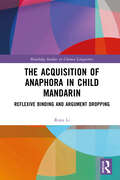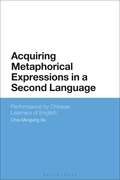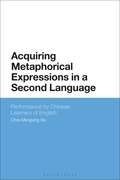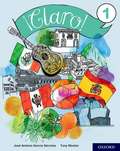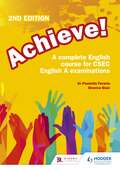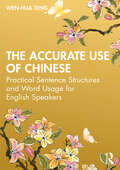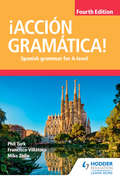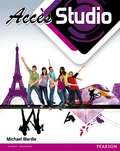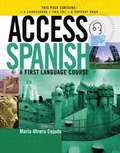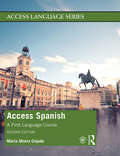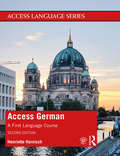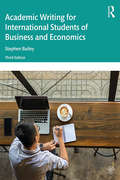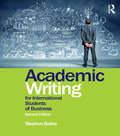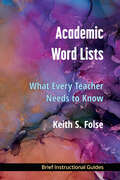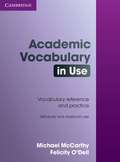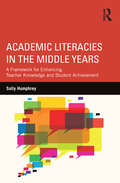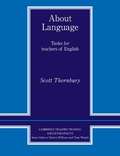- Table View
- List View
The Acquisition of Anaphora in Child Mandarin: Reflexive Binding and Argument Dropping (Routledge Studies in Chinese Linguistics)
by Ruya LiThe Acquisition of Anaphora in Child Mandarin explores how Mandarin-speaking children’s interpretation of the reflexive ziji and their use of null arguments can be understood under the notions of locality and prominence.This book investigates the interpretation of ziji and the use of null subjects and null objects by experimenting on Mandarin-speaking children and adults using a range of experimental techniques such as the truth value judgment task, the picture identification task, and the story-telling task.The book provides evidence to show that reflexive binding and argument dropping are determined by the interplay between universal principles and language-specific properties. It shows that children at the age of 4 make an adult-like distinction between the anaphoric and logophoric interpretations of ziji. The former is subject to the locality condition manifested by the blocking effect on the long-distance binding of ziji, whereas the latter is free from the locality condition and closely related to the understanding of the false beliefs of others.This book is an important contribution to language acquisition research and can serve as a valuable reference for graduate students and researchers in the field of language acquisition, Chinese linguistics, psycholinguistics, and cognitive science.
The Acquisition of Anaphora in Child Mandarin: Reflexive Binding and Argument Dropping (Routledge Studies in Chinese Linguistics)
by Ruya LiThe Acquisition of Anaphora in Child Mandarin explores how Mandarin-speaking children’s interpretation of the reflexive ziji and their use of null arguments can be understood under the notions of locality and prominence.This book investigates the interpretation of ziji and the use of null subjects and null objects by experimenting on Mandarin-speaking children and adults using a range of experimental techniques such as the truth value judgment task, the picture identification task, and the story-telling task.The book provides evidence to show that reflexive binding and argument dropping are determined by the interplay between universal principles and language-specific properties. It shows that children at the age of 4 make an adult-like distinction between the anaphoric and logophoric interpretations of ziji. The former is subject to the locality condition manifested by the blocking effect on the long-distance binding of ziji, whereas the latter is free from the locality condition and closely related to the understanding of the false beliefs of others.This book is an important contribution to language acquisition research and can serve as a valuable reference for graduate students and researchers in the field of language acquisition, Chinese linguistics, psycholinguistics, and cognitive science.
Acquiring Metaphorical Expressions in a Second Language: Performance by Chinese Learners of English
by Chris Mengying XiaConventional metaphorical expressions are widely used by native speakers in everyday language and have received extensive attention in theoretical semantics and cognitive linguistics. However, how a second language learner can acquire those expressions is left largely unknown. Researchers and language learners face the question: if one has acquired the literal meaning of a word, can they automatically derive the metaphorical meaning? This book provides the answer by placing the question of acquisition of metaphorical expressions in the framework of bilingual lexicon. Assessing whether metaphorical expressions are taken for granted by second language learners, it explores how the metaphorical meaning(s) of a word should be connected in a learner's mental lexicon, and how the cross-linguistic availability of a metaphorical expression could affect the outcome of acquisition of that expression. The book also provides a detailed comparison between metaphorical expressions and other figurative language from both the theoretical and experimental perspectives.
Acquiring Metaphorical Expressions in a Second Language: Performance by Chinese Learners of English
by Chris Mengying XiaConventional metaphorical expressions are widely used by native speakers in everyday language and have received extensive attention in theoretical semantics and cognitive linguistics. However, how a second language learner can acquire those expressions is left largely unknown. Researchers and language learners face the question: if one has acquired the literal meaning of a word, can they automatically derive the metaphorical meaning? This book provides the answer by placing the question of acquisition of metaphorical expressions in the framework of bilingual lexicon. Assessing whether metaphorical expressions are taken for granted by second language learners, it explores how the metaphorical meaning(s) of a word should be connected in a learner's mental lexicon, and how the cross-linguistic availability of a metaphorical expression could affect the outcome of acquisition of that expression. The book also provides a detailed comparison between metaphorical expressions and other figurative language from both the theoretical and experimental perspectives.
Ãclaro!. Volume 1
by Tony Weston José Antonio García Sánchez¡Claro! is the only Key Stage 3 Spanish course written specifically to prepare students for the rigours of the new GCSE specifications. Its accessible to all abilities, packed with fresh, lively content and written by a dynamic team of authors who believe in immersing students in Spanish-speaking cultures.
Achieve! A complete English course for CSEC English A examinations: 2nd Edition
by Paulette FerariaEnsure complete coverage of the new CSEC English syllabus with focused exam-practice and SBA guidance.- Test understanding with Paper 2 practice focusing on summary writing skills, expository writing, narrative discourse and persuasive discourse, plus practice Paper 1 items throughout.- Help students prepare for SBA with annotated examples and rubrics.- Develop comprehension skills with a genre-based approach.- Support students of all abilities with an in incremental approach that builds writing skills through practice exercises.
The Accurate Use of Chinese: Practical Sentence Structures and Word Usage for English Speakers
by Wen-Hua TengThe Accurate Use of Chinese: Practical Sentence Structures and Word Usage for English Speakers is a unique learning resource for learners of Chinese who are English speakers. The primary goal is two-fold: to help these learners leverage their existent knowledge in English and navigate the Chinese system with fewer obstacles; and also to help them prevent errors of which the underlying cause may be English. This is done through comparisons of selected grammar topics, language rules and word usages between the two languages. Grammar topics in English serve as the comparison points from which learners can gain a deeper understanding of the comparable, but differing structures in Chinese. The book's comparative approach is unique and innovative, designed to build a more nuanced and instinctive approach to grammar. A valuable resource for beginners to advanced learners and instructors of Chinese, the book contextualizes grammar structures and provides in-depth information not covered in Chinese language textbooks.
The Accurate Use of Chinese: Practical Sentence Structures and Word Usage for English Speakers
by Wen-Hua TengThe Accurate Use of Chinese: Practical Sentence Structures and Word Usage for English Speakers is a unique learning resource for learners of Chinese who are English speakers. The primary goal is two-fold: to help these learners leverage their existent knowledge in English and navigate the Chinese system with fewer obstacles; and also to help them prevent errors of which the underlying cause may be English. This is done through comparisons of selected grammar topics, language rules and word usages between the two languages. Grammar topics in English serve as the comparison points from which learners can gain a deeper understanding of the comparable, but differing structures in Chinese. The book's comparative approach is unique and innovative, designed to build a more nuanced and instinctive approach to grammar. A valuable resource for beginners to advanced learners and instructors of Chinese, the book contextualizes grammar structures and provides in-depth information not covered in Chinese language textbooks.
¡Acción Gramática! Spanish Grammar for A Level (PDF)
by Phil Turk Mike Zollo Francisco VillatoroMake Spanish grammar second nature with this trusted reference book containing over 300 activities - now completely revised in line with the new A-level specifications.- Supplement key resources in class or encourage independent practice at home, with clear explanations of the grammar points needed at A-level and knowledge-check exercises throughout - Prepare for assessment with longer application activities focused on developing writing skills such as translation and summary - Build confidence as exercises get increasingly more challenging to mirror students' advancement throughout the course - Check students' progress with regular grammar tests and all answers supplied online
Access Studio, pupil book (PDF)
by Michael WardleAccess Studio can be used as part of Heinemann's new Key Stage 3 French course, Studio. It covers the most common areas of vocabulary that pupils may have learnt in Key Stage 2. Access Studio can be used on its own at the beginning of Year 7, or alongside the Studio 1 Pupil Book to consolidate learning and aid revision. Covers basic vocabulary and structures from Key Stage 2. All units organised to allow maximum pupil independence. Topics include alphabet, numbers, colours, age, date, weather, school bag, family, food and sport.
Access Spanish - A First Language Course (PDF)
by Maria Utrera Cejudo Patricia GarciaAccess Spanish is the major new language course designed with the needs of today's generation of students firmly in mind. Whether learning for leisure or business purposes or working towards a curriculum qualification, Access Spanish is specially designed for adults of all ages and will give students a thorough grounding in all the skills required to understand, speak, read and write contemporary Spanish from scratch.
Access Spanish: A First Language Course (Access Language Series)
by María Utrera CejudoAccess Spanish: A First Language Course provides a thorough grounding in all the skills required to understand, speak, read and write contemporary Spanish from scratch. This fully revised edition consists of 10 units, each of which includes Language Focus panels explaining the structures covered and Descubre el mundo hispano boxes providing cultural insight into the Spanish-speaking world. Learning Tips and Ready to Move On checklists help students to achieve a sense of autonomy, while the accompanying website gives direct access to additional listening, reading and speaking activities, plus teacher support and guidance. Updated audio tracks for this edition are also available online at www.routledge.com/9781138476684. Access Spanish is ideal for adult learners and students at level A1–A2 of the CEFR, and Novice Low on the ACTFL proficiency scales.
Access Spanish: A First Language Course (Access Language Series)
by María Utrera CejudoAccess Spanish: A First Language Course provides a thorough grounding in all the skills required to understand, speak, read and write contemporary Spanish from scratch. This fully revised edition consists of 10 units, each of which includes Language Focus panels explaining the structures covered and Descubre el mundo hispano boxes providing cultural insight into the Spanish-speaking world. Learning Tips and Ready to Move On checklists help students to achieve a sense of autonomy, while the accompanying website gives direct access to additional listening, reading and speaking activities, plus teacher support and guidance. Updated audio tracks for this edition are also available online at www.routledge.com/9781138476684. Access Spanish is ideal for adult learners and students at level A1–A2 of the CEFR, and Novice Low on the ACTFL proficiency scales.
Access German: A First Language Course (Access Language Series)
by Henriette HarnischAccess German: A First Language Course provides a thorough grounding in all the skills required to understand, speak, read and write contemporary German from scratch based on everyday scenarios. This fully revised edition consists of 10 units, each of which includes language focus panels explaining the structures covered, cultural focus sections with current information from Germany and other German-speaking countries, and a comprehensive glossary. Learning tips and Ready to move on checklists help students to achieve a sense of autonomy, while the accompanying website gives direct access to additional listening, reading and speaking activities, plus teacher support and guidance. Access German is ideal for adult learners and students at level A1–A2 of the CEFR, and Novice–Low on the ACTFL proficiency scales.
Access German: A First Language Course (Access Language Series)
by Henriette HarnischAccess German: A First Language Course provides a thorough grounding in all the skills required to understand, speak, read and write contemporary German from scratch based on everyday scenarios. This fully revised edition consists of 10 units, each of which includes language focus panels explaining the structures covered, cultural focus sections with current information from Germany and other German-speaking countries, and a comprehensive glossary. Learning tips and Ready to move on checklists help students to achieve a sense of autonomy, while the accompanying website gives direct access to additional listening, reading and speaking activities, plus teacher support and guidance. Access German is ideal for adult learners and students at level A1–A2 of the CEFR, and Novice–Low on the ACTFL proficiency scales.
Academic Writing for International Students of Business and Economics
by Stephen BaileyThe third edition of Academic Writing for International Students of Business and Economics is written to help international students succeed in writing essays, reports and other papers for their English-language academic courses. Thoroughly revised and updated to reflect issues such as diversity and sustainability, this book is designed to let students and teachers easily find the help they need, both in the classroom and for self-study. The book is divided into five parts, comprising a total of 42 units: The Writing Process Elements of Writing Language Issues Vocabulary for Writing Writing Models New topics in this edition include Writing in Groups, Written British and American English and Reflective Writing. In addition, the new interactive website has a full set of teaching notes as well as more challenging exercises, revision material and links to other sources. Additional features of the book include: Models provided for writing tasks such as case studies and literature reviews Use of authentic academic texts from a range of sources Designed for self-study as well as classroom use Useful at both undergraduate and postgraduate level A complete set of answers to the practice exercises Cross-references across all units Providing a glossary to explain technical terms and written to deal with the specific language issues faced by international students of Business and Economics, this practical, user-friendly book is an invaluable guide to academic writing in English.
Academic Writing for International Students of Business and Economics
by Stephen BaileyThe third edition of Academic Writing for International Students of Business and Economics is written to help international students succeed in writing essays, reports and other papers for their English-language academic courses. Thoroughly revised and updated to reflect issues such as diversity and sustainability, this book is designed to let students and teachers easily find the help they need, both in the classroom and for self-study. The book is divided into five parts, comprising a total of 42 units: The Writing Process Elements of Writing Language Issues Vocabulary for Writing Writing Models New topics in this edition include Writing in Groups, Written British and American English and Reflective Writing. In addition, the new interactive website has a full set of teaching notes as well as more challenging exercises, revision material and links to other sources. Additional features of the book include: Models provided for writing tasks such as case studies and literature reviews Use of authentic academic texts from a range of sources Designed for self-study as well as classroom use Useful at both undergraduate and postgraduate level A complete set of answers to the practice exercises Cross-references across all units Providing a glossary to explain technical terms and written to deal with the specific language issues faced by international students of Business and Economics, this practical, user-friendly book is an invaluable guide to academic writing in English.
Academic Writing for International Students of Business
by Stephen BaileyInternational students of Business or Economics often need to write essays and reports for exams and coursework, and this new, second edition of Academic Writing for International Students of Business has been completely revised and updated to help them succeed with these tasks. This book explains the academic writing process from start to finish, and practises all the key writing skills in the context of Business Studies. The book can be used either with a teacher or for self-study, and is clearly organised into four parts, with each divided into short units that contain examples, explanations and exercises for use in the classroom or for self-study: The Writing Process, from assessing sources to proofreading Elements of Writing, practising skills such as making comparisons Vocabulary for Writing, dealing with areas such as nouns and adjectives, adverbs and verbs, synonyms, prefixes and prepositions, in an academic context Writing Models, illustrating case studies, reports, longer essays and other key genres This is an up-to-date book that reflects the interests and issues of contemporary Business Studies, with revised exercises, updated reading texts and a new glossary to ensure accessibility and maximise usability. Students wanting to expand their academic potential will find this practical and easy-to-use book an invaluable guide to writing in English for their degree courses, and it will also help students planning a career with international companies or organisations, where proficiency in written English is a key skill. All aspects of writing clearly explained, with full glossary for reference Full range of practice exercises, with answer key included Use of authentic academic texts Fully updated, with sections on finding electronic sources and evaluating internet material
Academic Writing for International Students of Business
by Stephen BaileyInternational students of Business or Economics often need to write essays and reports for exams and coursework, and this new, second edition of Academic Writing for International Students of Business has been completely revised and updated to help them succeed with these tasks. This book explains the academic writing process from start to finish, and practises all the key writing skills in the context of Business Studies. The book can be used either with a teacher or for self-study, and is clearly organised into four parts, with each divided into short units that contain examples, explanations and exercises for use in the classroom or for self-study: The Writing Process, from assessing sources to proofreading Elements of Writing, practising skills such as making comparisons Vocabulary for Writing, dealing with areas such as nouns and adjectives, adverbs and verbs, synonyms, prefixes and prepositions, in an academic context Writing Models, illustrating case studies, reports, longer essays and other key genres This is an up-to-date book that reflects the interests and issues of contemporary Business Studies, with revised exercises, updated reading texts and a new glossary to ensure accessibility and maximise usability. Students wanting to expand their academic potential will find this practical and easy-to-use book an invaluable guide to writing in English for their degree courses, and it will also help students planning a career with international companies or organisations, where proficiency in written English is a key skill. All aspects of writing clearly explained, with full glossary for reference Full range of practice exercises, with answer key included Use of authentic academic texts Fully updated, with sections on finding electronic sources and evaluating internet material
Academic Word Lists: What Every Teacher Needs to Know
by Keith S. FolseIn Academic Word Lists, Keith Folse explains how various lists like the Academic Word List (AWL) have become popular tools in the ESL classroom for teaching vocabulary. Following a discussion on the importance of teaching vocabulary, Folse explains why word lists are useful in language learning and how they can help address the lexical gap. He also outlines what words are on the AWL, how the word families are selected, and what teachers should know about other word lists. The book also includes 10 suggestions for using academic word lists in the classroom, including how to use vocabulary notebooks.
Academic Word Lists: What Every Teacher Needs to Know
by Keith S. FolseIn Academic Word Lists, Keith Folse explains how various lists like the Academic Word List (AWL) have become popular tools in the ESL classroom for teaching vocabulary. Following a discussion on the importance of teaching vocabulary, Folse explains why word lists are useful in language learning and how they can help address the lexical gap. He also outlines what words are on the AWL, how the word families are selected, and what teachers should know about other word lists. The book also includes 10 suggestions for using academic word lists in the classroom, including how to use vocabulary notebooks.
Academic Vocabulary in Use with Answers (PDF)
by Michael MccarthyThe perfect study aid for anyone using English for their academic work. Academic Vocabulary in Use is the perfect study aid for anyone using English for their academic work. Ideal for students of any discipline, from engineers or social scientists to business students or lawyers, it covers all the key vocabulary they will come across in academic textbooks, articles, lectures and seminars, allowing them to function confidently in an English-speaking academic environment. The book is designed for students at good intermediate level and above as well as those preparing for IELTS and other university entrance examinations.
Academic Literacies in the Middle Years: A Framework for Enhancing Teacher Knowledge and Student Achievement
by Sally HumphreyThe professional learning framework this book presents is designed to support teachers’ understandings of how language functions in their academic disciplines. This framework—a 4 x 4 metalinguistic toolkit—is informed by systemic functional linguistic theory and international educational research on academic and disciplinary literacies. The book shows and explains how teachers have applied specific 4 x 4 toolkits with students in middle school classrooms across a range of subjects for curriculum literacy instruction, assessment and feedback, resulting in substantial growth for their students in high-stakes national tests of literacy, as well as writing assessments in a number of subjects. In its focus on disciplinary literacies in diverse sociocultural settings, Academic Literacies in the Middle Years responds to contemporary international curricula for English language and literacy and the need for a strong evidence base for professional learning design.
Academic Literacies in the Middle Years: A Framework for Enhancing Teacher Knowledge and Student Achievement
by Sally HumphreyThe professional learning framework this book presents is designed to support teachers’ understandings of how language functions in their academic disciplines. This framework—a 4 x 4 metalinguistic toolkit—is informed by systemic functional linguistic theory and international educational research on academic and disciplinary literacies. The book shows and explains how teachers have applied specific 4 x 4 toolkits with students in middle school classrooms across a range of subjects for curriculum literacy instruction, assessment and feedback, resulting in substantial growth for their students in high-stakes national tests of literacy, as well as writing assessments in a number of subjects. In its focus on disciplinary literacies in diverse sociocultural settings, Academic Literacies in the Middle Years responds to contemporary international curricula for English language and literacy and the need for a strong evidence base for professional learning design.
About Language: Tasks for Teachers of English (PDF)
by Scott ThornburyTeachers of English need not only to have a good productive command of the language; they also need to know a good deal about the way the language works. This book asks: 'What is it that a teacher needs to know about English in order to teach it effectively?' It leads teachers to awareness of the language through a wide range of tasks which involve them in analysing English to discover its underlying system. The book consists of 28 units, each containing around ten tasks, plus a diagnostic introductory unit. Units start at phoneme level and progress through words, phrases and sentences on to complete texts. Task-types include recognition, categorisation, matching, explanation, and application tasks. Throughout the book, the language is illustrated wherever possible from authentic sources, so that the teacher can be sure that the English being studied represents current usage. 9780521561983 9783125332034
